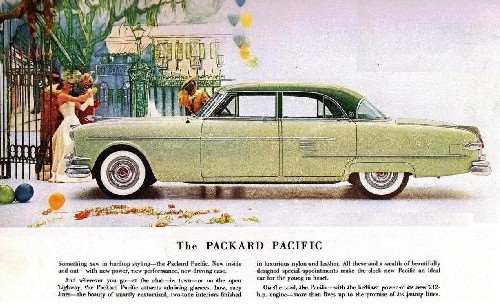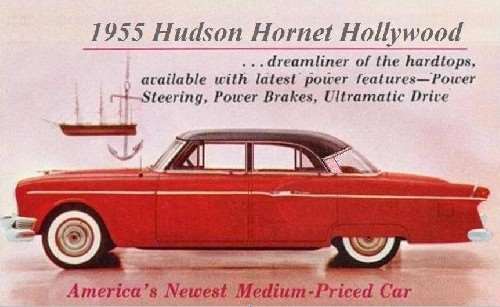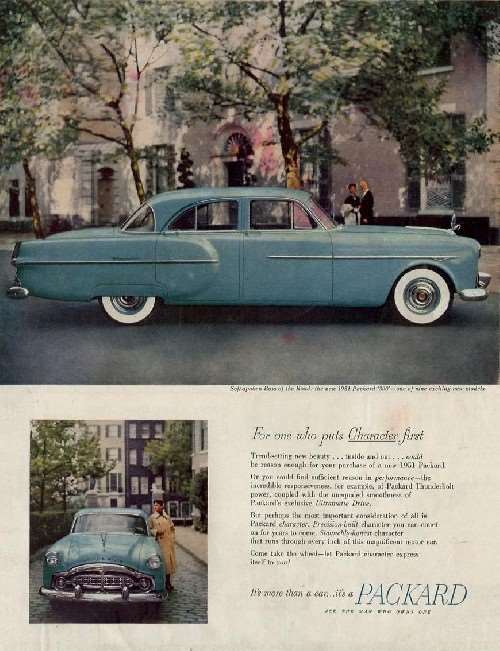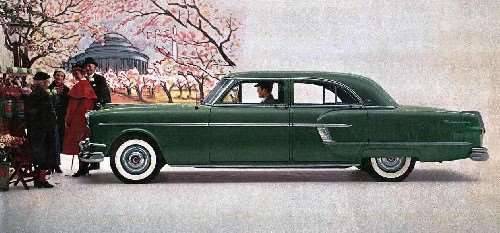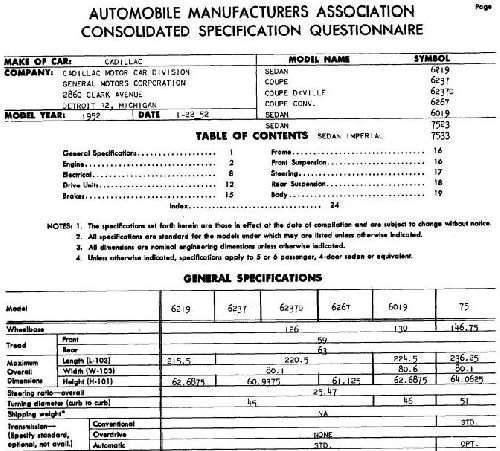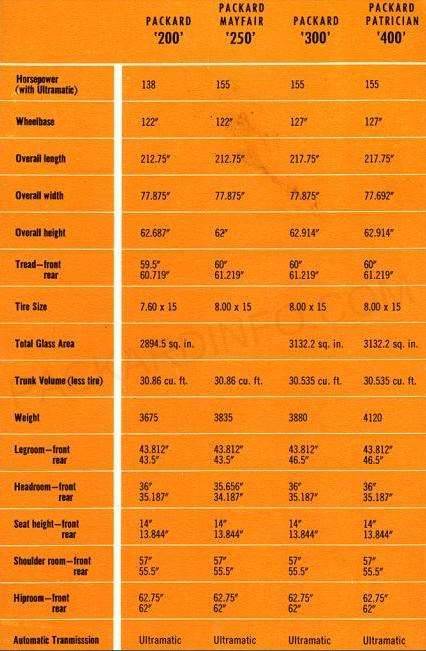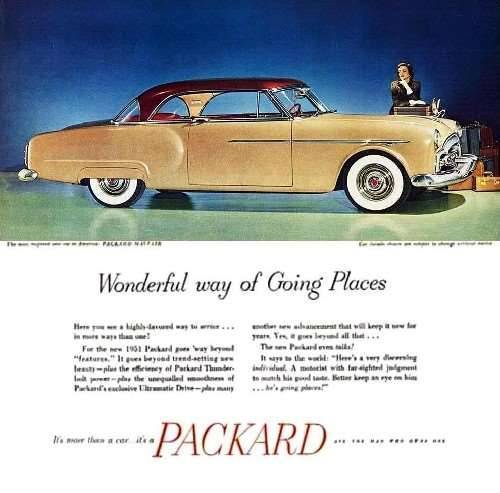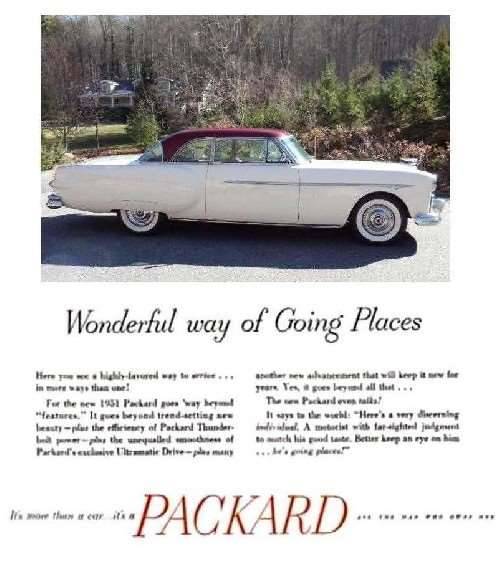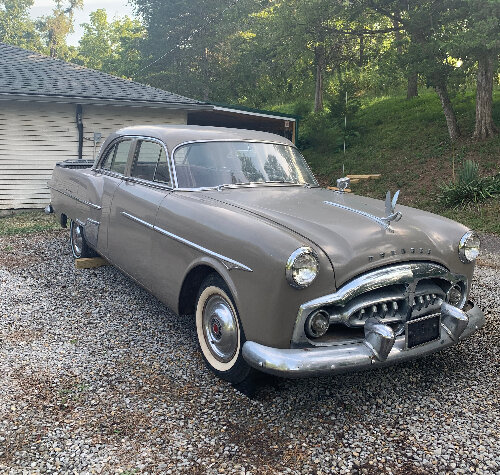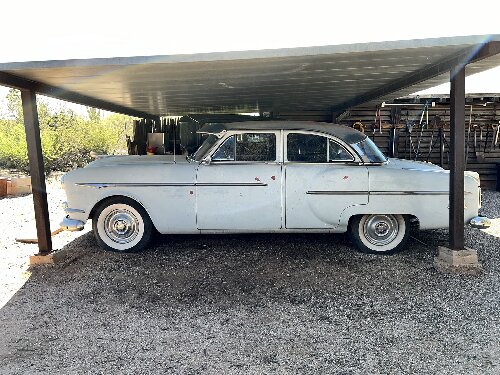|
Re: What would a traditional Packard "Senior" have looked like in 1951?
|
||||
|---|---|---|---|---|
|
Home away from home

|
<i>"Would just point out that the bathtub Nashes gave Nash the best years of their life, saleswise."</i>
Yes! In the "rising tide lifts all boats" scenario of the post war sellers market, Nash did well with those bathtubs. And, that styling trend was in vogue among the Independents then: Nash, Packard and Kaiser-Frazer succumbed to it. As much as I dislike the looks of the postwar Packard bathtubs, to my eye they are a thing of beauty in comparison to the Nash. <i>"They are also very nice to drive, especially the Ambassadors."</i> I've never driven one, but an uncle had one that I rode in a number of time as a kid. I remember it being very comfortable, much more so than the Plymouth my mother had at the time or the Chevrolet company car my father drove. <i>"There are Nash sales training films on Youtube that make no bones that the V8 Nashes were hard for the salesmen to sell because of the high price. Not to mention that '52 body was pretty hard to disguise, more so than Packard's countour. I am sure they would have also loved to have a new body for 55 but the economics probably were not there."</i> I'll have to go dig around YouTube for those. It would be interesting to see. I was not aware of the price issue. It makes me wonder if that wasn't a ploy on Romney's part to help kill off the full-size cars. I know that a bone of contention both ways between Romney and Nance was over the price they were charging each other for components. The unitized construction of the Nash made it as difficult to face lift as the unitized construction did to the "Step Down" Hudsons. There wasn't a lot they could do with it short of a full body replacement. <i>"I have spent some time driving around in cars with early Hydramatics and I comprehend FULLY why Packard did their own transmission. Whether in a Caddy, a Kaiser or a Nash, they always seem to be in the wrong gear while negotiating the hills and curves in the country and my best efforts with shop manual in hand fails to produce a less than jarring shift quality. Yes, they do take off with a rush, and they seem to be durable, but otherwise I find them annoying as all getout to drive."</i> Yes! While I have been critical of Christopher for not allowing the development of a V-8, I personally have never been critical of Packard for developing the Ultramatic. I also "get it" that they probably didn't have the resources to do BOTH the V-8 AND the Ultramatic. You comment about the shifting of the early Hydra-Matics takes me back to my childhood and my grandfather's Hydra-Matic equipped Oldsmobile 98s. I certainly remember their quirky performance - and that was on the flat roads of the Texas Panhandle. I was a "Gear Head" as a kid - and I remember thinking Grand Dad's Olds never seemed to be in the right gear.
Posted on: 2017/8/2 19:03
|
|||
|
||||
|
Re: What would a traditional Packard "Senior" have looked like in 1951?
|
||||
|---|---|---|---|---|
|
Home away from home

|
<i>" 'leap and lurch' transmission"</i>
 Spot on! Also, see my response to Ross's comments about the Hydra-Matics. 
Posted on: 2017/8/2 19:06
|
|||
|
||||
|
Re: What would a traditional Packard "Senior" have looked like in 1951?
|
||||
|---|---|---|---|---|
|
Home away from home

|
"I have to disagree with concept of that 1954 Packard advertisement. No wonder James Nance hated Packard advertising! That photo shows some creepy older guy squiring an attractive younger lady with a four-door sedan in the forefront. These were not the people Packard should have been trying to appeal to. By the early 1950s the advertising industry generally tried to appeal to young families or carefree driving in convertibles. Nance was correct when he said that the ad agency handling the Packard account had dropped the ball and that what was appearing in magazines and newspapers was pathetic. By 1954 a Packard was no longer a status symbol."
That's a great point. A more youthful and sporting nature were the future. Ironically, Packard ads in the Twenties and Thirties sometimes communicated just that and Pierce-Arrow long played in that space. I have no sympathy for Nance, though. He needed look no further than the mirror for 1954's problems. If we take May, 1952 - his arrival - as starting point, where he inherited Ferry's half-baked showroom that sold fairly well against Buick, Olds and others in the $2500 price range but completely flopped in the $3200 Buick and $3600 Cadillac range, and inexcusably abstained from the $4200 Sixty Special range, what could he have done? I think it's pretty simple and this isn't just hindsight, if internal and external complaints of the day are any indication. Instead of firing old hands and replacing them with Hotpoint kitchen help, then wasting a year having the busy bodies cook up hundreds of charts and graphs, Nance should have posed a simple question to the existing Packard team: "How can we turn things around against Cadillac, affordably and in short order?" Engineering would have suggested all the things they eventually delivered - V8, reworked Ultramatic, innovative new suspension, power steering, integrated A/C. Marketing would have suggested that Packard's upper range distance itself from the lower range, which Nance would have liked. Manufacturing would have said bring body production in house to get the quality up and costs down. And finally, Design would have weighed in, in typical oblivious fashion: "Mr. Nance, we need an all-new car with a fresh, modern appearance that is longer, lower and wider." "Yeah, and I need my receding hairline to grow back! Come on guys, tell me something I can afford and have ready for 1954." Here's where Design would have needed to think hard. What was more important, fresh appearance or better proportions? They could only have one. The first would have led to the '55 design they eventually delivered. The second? Let's fantasize that Nance chose Door #2 and the team hustled to put out a 1954 Pacific line that included a 132 wb (I shortened the hood extension from 6 to 5 inches because it looked better) sedan with hardtop roof style and 1.5 inches sectioned from body, and a 127 hardtop coupe and convertible with 5 inch shorter body than sedan. Maybe the program would have involved lots of new tooling, or maybe simply 5 inch extensions added to fenders, hood, deck and roof, and panels sectioned in the body shop. The sporting new line would have necessarily been priced in the Sixty Special range. For advertising, "Pacific" and sleek new lines would have targeted west coast's new rather than Patrician's east coast old money. For imagery I think the attractive model in evening gown was still in order, though less stuffy and pretentious and more like Grace Kelly - light hearted and whimsical. The 1954 Pacific brochure did just fine with the backdrop imagery and words. It was Nance who didn't deliver the car.
Posted on: 2017/8/5 8:00
|
|||
|
||||
|
Re: What would a traditional Packard "Senior" have looked like in 1951?
|
||||
|---|---|---|---|---|
|
Home away from home

|
Had it not been for the Korean War, Packard might well have set up body production back at East Grand Boulevard in time for the 26th Series, in late 1952. According to Robert Neal's "Packard - 1951 to 1954" book (Chapter 3), a sub-committee had been set up on April 12, 1950 for just such a purpose. However, the $2 million cost to accomplish this was, by August 17, 1950, deemed too high a cost. The August 17, 1950 minutes of the sub-committee state: "The present situation which has developed with this trouble in Korea, which indicates that the procurement of materials will become increasingly difficult and may end in their allocation, that it is not an appropriate time to consider the project further."
As to the discussion about the new V-8 engine - Nance's team did not authorize production of the engine until March of 1953. Serious discussions were taking place before then, however. Robert Neal quoted the minutes of the Operating Committee meeting of January 2, 1951 in his book "Master Motor Builders" (Chapter 7): "A preliminary cost study of the V-8 engine for use in the 26th Series [1953] has been completed by the Manufacturing Division, and Mr. Reifel reported that it indicated a tool cost of approximately $13 million with a slight increase in piece cost." "By January of 1952," Neal wrote, "the committee had approved spending $1.2 million for the development of the necessary machine tools to set up a modern new engine production facility. By the end of 1953, $3 million had been spent on design, tooling and prototype production of a new V-8 engine, and the company was contemplating further outlay of some $14 million before complete production facilities would be in place. Necessary funds to complete this process were not committed until 1954... There is ample evidence that the engine was designed and prototypes built by early 1953."
Posted on: 2017/8/5 9:31
|
|||
|
||||
|
Re: What would a traditional Packard "Senior" have looked like in 1951?
|
||||
|---|---|---|---|---|
|
Home away from home

|
How in the world did Packard go from an initial 1953 to a final 1955 model year launch for the V8? Seems both Ferry and Nance dithered way too long.
$2M to bring body production in-house seems a drop in the bucket compared to the tens of millions in capital outlay and losses in 1954-56. In thinking further about Nance's options, had he instructed his team to create a 1954 Pacific series along lines above, might well have concluded that the sectioned bodies and hardtop roof could have been mated to standard length hood and deck too, replacing Cavalier and Patrician with a single series. Where things could have really gotten interesting is when Barit approached Nance in August 1953 asking to merge. With word of Conner being sold to Chrysler at around same time would have been opportune moment, Hudson taking on all Packard-Hudson body production. $18M in Hudson losses in 1954 would have been price paid to get its dealers and repeat customers, perhaps a better long term solution than creating stand-alone Clipper brand. In this scenario Hudson could have gotten the sore thumb taillights and a wrapped backlight in keeping with Jet. Vehicle height with sectioned body would have been within a half inch of the Step-Down that the new series replaced. Maybe this would have been the right time to walk away from the shorter Packards. Alternatively, if Hudson didn't join, the car would have made a great Clipper replacement.
Posted on: 2017/8/5 15:25
|
|||
|
||||
|
Re: What would a traditional Packard "Senior" have looked like in 1951?
|
||||
|---|---|---|---|---|
|
Home away from home

|
A little fun with a 1951 300 advertisement working back from the '54 132 wb car above, again adding 5 inches to deck and hood. I think the changes really bring the car into good proportion and lend an air of majesty. As with the Pacific ad, the words work just fine, only needing a grand car to accompany.
Posted on: 2017/8/11 20:25
|
|||
|
||||
|
Re: What would a traditional Packard "Senior" have looked like in 1951?
|
||||
|---|---|---|---|---|
|
Home away from home

|
Had Ferry instructed his team to simply match Cadillac for 1951, the 132 wb car above would have not only matched 60 Special in size and presence, it's good proportions would have enabled lots of other wonderful products. For example, starting with the coupe's 9 inch longer front doors Packard could have cut 4-1/2 inches off the outer panels and welded them to the front of the rear doors. (obviously more would have been involved!) The longer front doors would have aligned the B-pillar with division window while the longer rear doors would made entry/egress easy for the "money". Welding in a 9 inch roof section above the B-pillar and closing in the C-pillar would have completed the package, enabling Packard to create and own a new 2-row executive limo segment. The car would have looked great and helped restore the Packard name.
Posted on: 2017/8/12 20:51
|
|||
|
||||
|
Re: What would a traditional Packard "Senior" have looked like in 1951?
|
||||
|---|---|---|---|---|
|
Home away from home

|
Other cars the 132 wb sedan would have enabled would have been a hardtop coupe and convertible that were more competitive with Cadillac. I couldn't find detailed specs for the '51 Packard or '49 and '50 Cadillacs that Ferry would have known about during development of the 24th Series but I did find '52 info for both. Looking at the specs it is clear that Packard's 2-door models weren't long or low enough to compete with Cadillac's Series 62 cars.
The 132 sedan would have made available 5 inch longer front fender and hood stampings, a good start but probably still not enough. The cars would have needed Reinhart's hated 1.5 inches sectioned out of the body. With these changes and perhaps the big "400" 190 HP engine underhood I think the cars would have had the right stuff and fetched pricing right up there with Coupe DeVille. With all these models including the 141 wb Formal Sedan above, Nance would have inherited a much better situation upon which to build. 8/15 EDIT: after finding a one-off '52 hardtop with 300/400 rear fenders and taillights, concluded that Packard might have benefited most by fielding two hardtops. The first is attached here as replacement for what I had originally posted. It still has 1.5 inches sectioned from the body but now has standard hood length and 122 wb. This is the car that needed to compete with the Buick 50 and 70 Series hardtops. More soon on the other model.
Posted on: 2017/8/13 11:00
|
|||
|
||||
|
Re: What would a traditional Packard "Senior" have looked like in 1951?
|
||||
|---|---|---|---|---|
|
Home away from home

|
Here's the other hardtop (see 8/15 EDIT in previous post).
I have been trying to use factory photos and ads but in this case had to alter a photo of a current car (with much appreciation to its owner) because it appears to be a '52 Mayfair one-off with 300/400 rear fenders and taillights, presumably modified after production. The existence of this car made me realize that these Senior design elements together with the 132 sedan's extended hood and deck could have been used for the top-of-line hardtop and convertible to enable them to fully compete with Coupe DeVille. The attached work-up also sections the body 1-1/2 inches just like the tan/red car above. The result would have been elegant sporty cars that were longer than needed to compete with the '50-51 CdV but perfectly matched against the '52-53 CdV that used 60 Special's longer deck. Note that the advertising works fine for this car just as it does for the tan/red car, only instead of communicating a person "going places" up the societal or corporate ladder it suggests an affluent owner who has arrived at his or her weekend retreat far from the city. Am beginning to see a two-tier showroom materialize, one that would have kept Packard competitive with Buick in the $2500 - $3200 range while successfully battling Cadillac's most expensive models. The lower tier would have used the 200's taillights and standard length hood and deck while the upper tier would have used the 5 inch extended hood, deck and rear fenders, proudly displaying its bulls nuts. Design elements crossing over would have been the upper tier's wrapped backlights, which would have by necessity been used on the 122 wb hardtop and 127 wb sedan. A missing link is the 400 Patrician. Perhaps the lower tier 127 wb sedan that competed with the Buick 70 could have also been offered in a higher trim level that approached Cadillac's Series 62 sedan. Lots of fun!
Posted on: 2017/8/15 19:19
|
|||
|
||||


 (159.17 KB)
(159.17 KB)